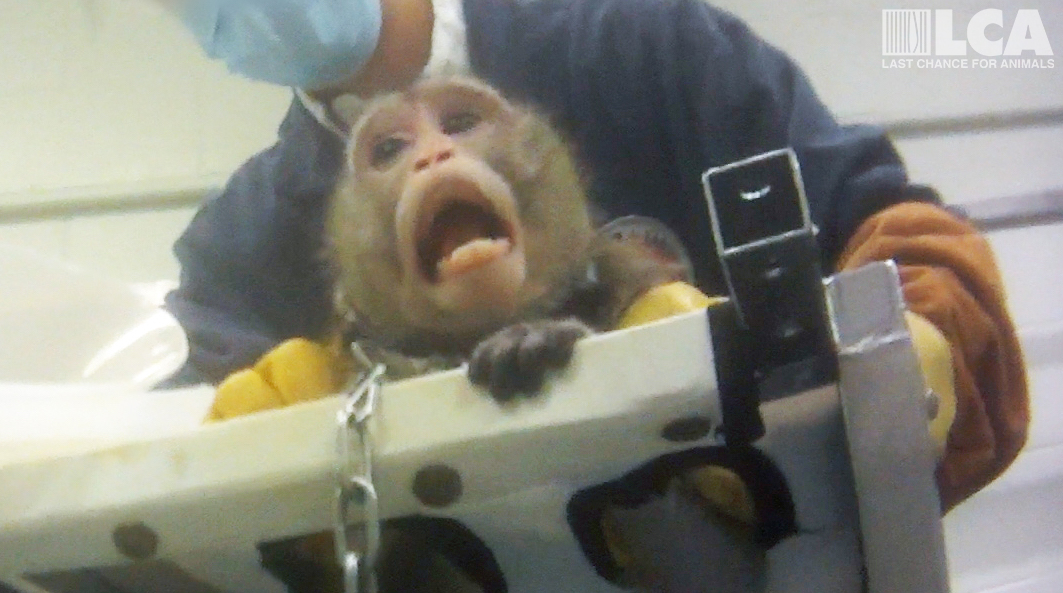Animal Welfare Violations Revealed in LCA’s Investigation of ITR Toxicology Labs

Workers performing painful and stress-provoking procedures on mini pigs and macaques in the presence of other mini pigs and macaques, causing distress
Sign LCA's Petition Demanding Justice for Animals Abused by ITR Labs
The CCAC Guide to the Care and Use of Experimental Animals, Volume 1 clearly specifies that:
“Invasive procedures that may cause distress to other animals should be conducted in a procedure room rather than in an animal holding room. All procedures that might cause distress to an animal should be conducted outside the animal holding room since a distressed animal may convey alarm to conspecifics and induce unnecessary stress in other animals in the room. This may include relatively minor procedures involving transient restraint, such as injection or collection of small blood samples, especially where wild animals are involved, and includes all invasive procedures. Minor procedures, such as the injection of laboratory rodents, may be conducted in designated spaces within the animal holding room. Where rodents are housed in ventilated cage racks, procedures may be conducted within a procedure hood in the same room.” (pg.18)
ITR uses mini pigs in dermal and gavage (forcefeeding) studies, and houses these animals in rooms that segregate them by study. The pigs are kept in individual cages with solid stainless steel sides and a wire front door that allows visual access to the activities of the technicians. The composition of the rooms also amplifies the animals’ vocalizations.
During the dosing phase of a study, pigs are removed from their cages by technicians and placed into restraints, then dosed either by a gavage tube inserted into their esophagus and fed into their stomach or by dermal application of the study substance. These procedures are conducted in the middle of the holding room, in front of the rows of cages where the rest of the study subjects are housed. Pigs react to both of these procedures in a manner that conveys distress to the other animals in the room by the simple fact that they are in plain sight and vocalize with increasing amplitude.
Placing a pig in a sling for restraint for dermal applications requires tethering the animal’s legs underneath a canvas sling throughout the procedure. One or more technicians then places their hands on the pig to manually restrain them. If a pig twists or thrashes in the sling, a lead technician will ask the other techs to lean across the pig’s shoulders and apply great force. A tech may also be asked to hold a pig’s snout closed, so they cannot open their mouth, in an attempt to calm their vocalizations.
After the pig is restrained, the study material is applied to their back. This also causes the pig clear distress due to the reactive nature of the substance being tested. During LCA’s investigation at ITR, pigs used for a dermal study were suffering from red, raw skin from daily applications of a pharmaceutical cream. This intensified the pig’s reaction, compounding the stress of handling and restraint with the pain of irritated dermal tissue.
Pigs involved in gavage studies are also dosed in the study room. They are removed from their cages and then placed in a plastic seat that rests at floor level and allows one technician to position themselves behind the animal. The seated technician holds the pig upright, resting on its rump, and the pig’s limbs are tethered to further restrict movement. The technician then places a plastic gag over the pig’s snout, which keeps its mouth open so that the gavage tube can be inserted. Pigs struggled so hard to resist the gagging that the plastic would have blood on it after removal. The procedure ended with the insertion of the gavage tube down the pig’s esophagus and the depositing of the study material into the animal’s stomach.
After dosing, pigs are subjected to blood draws, performed while the animals are restrained in the canvas sling. Technicians would lean across the pigs’ backs with their full bodyweight and attempt to hold their snouts to keep the pigs from moving their heads. Another technician would crouch under the sling and draw blood from the neck area of the pigs, sometimes requiring multiple insertions of the syringe.
ITR also uses cynomologous and rhesus macaques in gavage studies. Macaques are singly housed in stainless steel cages with solid walls, top panels and a wire front door. The cages are set at an angle to the walls, facing inward, so the macaques have a wide view of the technicians entering the room as well as their fellow macaques.
For all procedures, including routine blood draws and weighing, macaques are removed from their cages and placed in restraint chairs that consist of a piece of HDPE material suspended in a metal frame with a hole in the middle for the macaque’s head to pass through. While in the restraint chair, macaques cannot cover their head or face with their limbs, and they are often further immobilized by technicians holding them from underneath. Once restrained, they are dosed via gavage tube and then returned to their cage. Another macaque -- who would have been watching this procedure take place -- is removed from its cage and brought to the restraint chair for the process to be repeated.
Macaques are also used in studies where they are dosed via intravenous catheter. Before these studies begin, the macaques go through a process called “acclimation,” where they are kept restrained in a canvas sling for a period of time. The macaques have their necks chained to the metal support struts of the sling, and are fitted with an Elizabethan collar. Their limbs are tethered under the sling to further restrict their movement.
The macaques placed in acclimation have never experienced this type of handling and restraint before, which may cause elevated levels of reactivity. Macaques can be observed making exaggerated facial expressions, vocalizing, attempting to escape the tethers, and as a final resort, thrashing violently. All of the acclimation procedures are carried out in the study room that houses the other macaques.
ITR conducts invasive procedures within the confines of the animal holding rooms, thereby causing distress to the other animals who are subjected to the reactions of their conspecifics. The auditory protests, physical attempts at avoidance and facial expressions of fear are audible and visible to the cage-bound animals in direct violation of this guideline, and thus not part of generally recognized research rules (as per section 7) and in violation of section 6(3) of the Animal Welfare and Safety Act. In some of the examples, ITR’s toxicology director is seen observing the procedures along with study directors and the study sponsor representative.
Macaques are wild animals, and react in a heightened state of reactivity to being handled. Macaques can be heard making high-pitched calls and barking aggressively while being manipulated by technicians, and can be seen thrashing violently to escape their restraints during study protocols.
Housing macaque monkeys in cages not suitable for the needs of their species in violation of section 3 of Regulations Respecting Animals in Captivity
Macaques at ITR are housed either singly during studies or with up to two additional cage-mates while in the “spare colony” or while waiting to be used for a research protocol. They are housed in barren 34" X 45.5" X 34.25"h stainless steel cages that occasionally contain a perch or a toy.
Macaques in both of these housing arrangements exhibit behaviors commonly attributed to the stresses of being confined in a manner that is not suitable for the needs of their species. One macaque in particular, #2502, has large visible patches of hair missing along her sides. She repeatedly spins in circles in her cage, leaning backwards with her head, each time forming a tight circular pattern. The ritualistic pattern of movement begins and ends at almost the exact same spot within the confines of the cage and is documented on numerous days, replicated in exactly the same fashion.
Two macaques housed in another study room have apparent hair loss on their forearms, and one of them exhibits a repetitive rocking motion while hanging to the side of the wire cage. The pattern of hair loss appears to be in exactly the same location on both of the macaques, and the macaque’s pattern of movement is exaggerated and repeated in such a manner as to be unnatural.
Macaques housed in groups of four to a cage also exhibited abnormal behavior. The LCA investigator documented one macaque sitting, clearly visible in the wire mesh extension cube in its cage, pulling hair from its cage mate’s back and eating it. The macaque who submits to this behavior has a large patch of hair missing from his back.
Not only does ITR not utilize any strategies to mitigate this behavior, but during the LCA investigator’s first encounter with the macaques they are told not to record hair loss in the daily health records by the technician that is training them according to ITR protocols. The fact that key indicators of the psychological health of animal subjects housed in sparse and restrictive settings and subjected to painful and stressful procedures are not seen as relevant data to be collected places the burden of responsibility for the causation of extreme anxiety and suffering with ITR management.
ITR is clearly keeping macaques in cages that are not suitable for the needs of their species, consequently causing them extreme anxiety and suffering. The expression of this anxiety and suffering is apparent in the macaques who repeatedly circle and rock in their cages, and by the patterns of hair loss on their sides and forearms due to hair plucking from the stress of confinement. ITR has, however explicitly, instructed its technicians to not record hair loss, one of the most obvious and easily observable signs of anxiety, thereby eliminating this indicator as a daily barometer for the psychological health of the animals.
Infusion Studies
ITR keeps beagle dogs housed singly in stainless steel cages approximately 34" X 45.5" X 34.25"h, with slatted floors and wire front doors. The beagles are housed in this fashion for the duration of their lives at ITR, and are not provided with any type of environmental enrichment other than a toy, which beagles in the infusion study wearing an Elizabethan collar would be unable to use due to the permanent wearing of a cone. This prevents the animals from expressing any natural behavior.
The restrictive nature of this housing places psychological burdens on the animals, who exhibit varying degrees of stress-related behaviors including repetitive pacing, circling, barking and pawing at cage doors.
Beagle dogs at ITR, when used in infusion toxicology and other types of toxicology testing, are held individually for the duration of their lives. Purpose-bred beagle dogs arrive at ITR as young as six months of age and are immediately placed in individual cages. If they are to be used in infusion studies they are fitted with catheters, infusion jackets and cones after two weeks. The dogs are utilized in studies lasting up to nine months, and upon completion they are killed and necropsies performed for the study sponsor.











